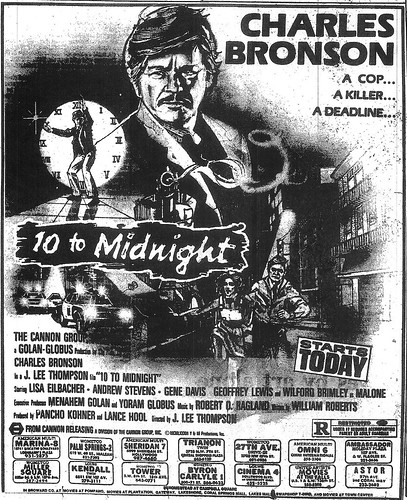
’ TEN TO MIDNIGHT ’ IS ONE VICIOUS FILM
Miami Herald, The (FL) - March 22, 1983
Author: BILL COSFORD Herald Movie Critic
The quaint old American notion of due process takes another drubbing in Ten to Midnight , a shabbier-than-usual Charles Bronson vehicle, and it may be time to accept a few things about Bronson’s philosophy.
Bronson could be forgiven Death Wish, the 1974 vigilante drama, for that film was as powerful as it was mean-spirited. With somewhat greater unease, one could also forgive the lifeless sequel, Death Wish II, on the grounds that Bronson was only an actor mired in a bad property. But in Ten to Midnight , at about the time that Bronson shoots a suspect firm in the grasp of arresting officers, we understand: Bronson means it. He favors reversal of the ordinary sequence of capital justice, so that execution comes first, before the bother of a trial.
Ten to Midnight has the faint aroma of the once-shelved project about it -- Bronson looks considerably younger than he did in Death Wish II, and the title of the film bears no relation to its substance, suggesting a name change somewhere along the way -- but its message is clear. The villain is carefully drawn as a figure whose death we can all applaud: He’s a slasher who runs naked through the student nurses’ dormitory, gutting innocents. Bronson plays a veteran cop who doesn’t buy the guy’s ironclad abili. In protest against the notoriously porous criminal justice system, Bronson’s cop plants evidence on the slasher and reveals his creed: "Forget what’s legal; do what’s right."
The Bronson character is caught and fired from the force, but as the authorities mysteriously allow him to keep his gun and his squad car, the movie bumps steadily along to its climax, summary execution. The final scene is so foul that even ya-hoos have trouble mustering much applause; it’s the kind of film that makes you feel dirty. As for Bronson, whose box-office appeal has faded as the viciousness of his films has increased, Ten to Midnight is a kind of milestone: It’s time to write him off.
Movie Review
Ten to Midnight (R) No stars
....
CAST
Charles Bronson , Lisa Eilbacher, Andrew Stevens, Gene Davis, Geoffrey Lewis, Wilford Brimley
CREDITS
Director: J. Lee Thompson
Producers: Pancho Kohner, Lance Hool
Screenwriter: William Roberts
Cinematographer: Adam Greenberg
Music: Robert O. Ragland
....
A Cannon Films release
....
Vulgar language, nudity, implicit sex, violence and gore
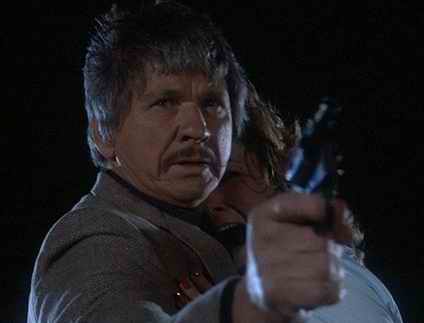
REVIEWS / MOVIES.. BRONSON FIRES A BLANK.. 10 TO MIDNIGHT - STARRING CHARLES BRONSON , DIRECTED BY J. LEE THOMPSON,.. WRITTEN BY WILLIAM ROBERTS, COSTARRING LISA EILBACHER AND ANDREW STEVENS,.. AT THE SAXON AND SUBURBS, RATED.. R.
Boston Globe - March 12, 1983
Author: Michael Blowen Globe Staff
Charles Bronson knows his bread and butter is blood and guts. Unlike Clint Eastwood, the other king of vengeance, Bronson would never trade his gun for a guitar.
In " 10 to Midnight ," Bronson plays a cop whose daughter is being pursued by a slasher. Naturally, police procedure and the legal system are too slow so Bronson, true to his manic screen persona, takes matters into his own hands.
"I’m a mean, selfish SOB," he tells another cop, "I want a killer, and what I want comes first."
Warren, the killer, is a Tony Perkins clone who takes grisly delight in taking off his clothes, sliding a pair of surgical gloves over his hands and slashing any woman who won’t go out with him. As Bronson quips, "the law protects these maggots as if they were an endangered species."
Bronson’s vigilante cop, although a bit gray around the edges and a bit long in the tooth, is still able to handle these young whipper snappers. No fooling around in court with him. No bill of rights. No defendant’s rights. No Miranda decision. His idea of due process is a quick 44 caliber cartridge blasted into his foe’s forehead.
Although the scenes of violence are grotesquely, and typically, Bronsonesque, even his fans will be disappointed by the film’s lumbering pace. Veteran directorial hack J. Lee Thompson can’t even keep up with the veteran actor. He builds suspense by having one of the victims fry a couple of eggs. Everyone else in the film just lays them.
BRONSON, HIS NEW FILM ARE BOTH TIRED
Philadelphia Inquirer, The (PA) - March 12, 1983
Author: Steven X. Rea, Inquirer Staff Writer
Charles Bronson looks depressed: The hair is gray, the skin is puffy. The flab under his eyes hangs like a pair of old coats. A network of lines and scars crisscross his haggard mug like rivers of woe.
And, hey, who can blame the guy? If you had to star in another one of those low-budget, one-man-vigilante movies you’d be unhappy, too.
This time, it’s something called 10 to Midnight (exactly why it’s called this is never made clear), in which Bronson plays a Los Angeles police lieutenant stalking a psychopath who runs around nude, slashing young, beautiful women. The killer - portrayed with cliched creepiness by Gene Davis - feels rejected by said beauties so he decides to kill as many of them as he can. Bronson has a personal interest in getting this maniac off the streets: He’s got a young, beautiful daughter (Lisa Eilbacher) who’s been getting a lot of obscene phone calls lately.
Directed in plodding TV-movie style by J. Lee Thompson from a sorry excuse of a screenplay by William Roberts, 10 to Midnight has little more to offer than a few brutal, ugly stabbings, some nudity and a lot of hackneyed Dirty Harry rhetoric about how judges and lawyers are making it impossible to keep the "maggots" and "vermin" and "scum" in jail where they belong.
Taking a cue from his Death Wish pictures, Bronson takes the law into his own hands yet again, compromising his position on the force by tampering with evidence. He’s going to get this slimeball even if he has to plant evidence and violate people’s constitutional rights. If he did any less, the audience might walk out.
As it is, sitting through 10 to Midnight is an endurance test. Bronson’s not the only one who looks weary and dismayed: Wilford Brimley, armed with walrus-mustache, wire-rims and a stupefied stare, sleepwalks through his scenes as Capt. Malone, Bronson’s boss, and Andrew Stevens, as the young-cop- who-doesn’t-look-or-act-like-a-cop cop, brings his usual depthlessness to the role.
Bronson, unlike Clint Eastwood and Burt Reynolds, hasn’t been able to parlay his tough-guy character into anything more than a series of dismal tough-guy movies. With 10 to Midnight , the actor has truly hit rock-bottom. You almost feel sorry for him.
But almost, as we all know, doesn’t count.
10 TO MIDNIGHT
Produced by Pancho Kohner and Lance Hool, directed by J. Lee Thompson, written by William Roberts, photography by Adam Greenberg, music by Robert O. Ragland, and distributed by Cannon Films; running time, 1 hour, 41 mins. **SINGLEG*Leo Kessler - Charles Bronson
Laurie Kessler - Lisa Eilbacher
Paul McAnn - Andrew Stevens
Warren Stacey - Gene Davis
Capt. Malone - Wilford Brimley
Parents’ guide: R (nudity, violence)
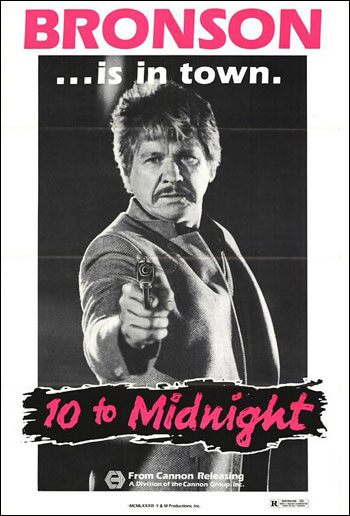
HIGH-BROW TALK CAN’T MASK (PORNO)GRAPHIC VIOLENCE
Philadelphia Daily News (PA) - March 14, 1983
Author: JOE BALTAKE, Daily News Movie Reviewer
" 10 to Midnight ." An action drama starring Charles Bronson . Directed by J. Lee Thompson. Adapted by William Roberts from a story by Thompson. Photographed by Adam Greenberg. Edited by Peter Lee Thompson. Music by Robert O. Ragland. Running Time: 100 minutes. In area theaters. (Screened at the Ellisberg Circle Cinema, New Jersey)
Some 20 years ago, director J. Lee Thompson dedicated his "Cape Fear" to the lurid study of a revenge-bent sociopath (played to a sexually threatening hilt by Bob Mitchum).
Despite the filmmaking restrictions of the time (1962), "Cape Fear" was as relentlessly amoral and asocial as the psycopathic personality it dissected, showing no mercy either to the harrassed characters in Thompson’s plot or to the terrorized people in its audience.
We are a long way from the discreet ’60s, and " 10 to Midnight " - more or less, Thompson’s follow-up to "Cape Fear" - shows how appalling artistic freedom can be. Artistic freedom? In this case, one word contradicts and discredits the other.
This update of the brute, sexually repressed harassments of an unhinged ’’creep" (the movie’s word, not mine) is so graphic in its scurriliousness that I was alternately embarrassed, ashamed and afraid, wishing I had worn a body-size prophylactic to the performance. This is a diseased film.
"His knife is his penis," police detective Charles Bronson comments in an attempt to explain the unhinged creep’s sexless attacks on attractive young
sexually active women. William Roberts’ screenplay is rife with similar purple dialogue, as well as a few fancy five-dollar words ("propitious," ’’inure," etc.), as if to prove that " 10 to Midnight " is more intelligent than other crass slasher flicks.
However, while the cops here try to be as analytical and high-brow in their expressions as possible, Thompson’s visuals reduce " 10 to Midnight " to what it really is - new-style porno, with the accent on violence. Inexplicably, his killer (Gene Davis, who looks, sounds and acts like Brad Davis) performs his foul deeds in the nude, with Thompson’s camera always playing up the phallic symbolism of his bloodied knife.
The movie also has its share of vaginal symbols, and reaches a crazed, sexual peak when Davis uses his knife to break into a victim’s nightstand (to seize and destroy an incriminating diary). Thompson dwells on this moment so long and so feverishly that he gives new meaning to the expression "forced entry."
The reason for these vicarious rapes, Prof. Bronson continues to explain, is because - that’s right! - the unhinged creep can’t make it with women.
The pervasive sordidness of " 10 to Midnight " is relieved by neither humor (there’s isn’t any) nor the film’s performances - the worst collection ever assembled for one movie (with the possible exception of Lisa Eilbacher as Bronson’s pert daughter and Wilford Brimley as his boss). It is a commentary of the calibre of the film’s acting that everyone else here looks much more guilty and seems more sociopathic than the villain.
This is particularly true of Andrew Stevens, who plays Bronson’s Golden Boy partner. (He’s the one who uses the word, "inure.") Stevens’ cop is so nice and so well-adjusted that he’s not a real person at all.
Creepy.
Parental Guide: Rated R, leniently so, for its nudity, violence and language.

KINKY KILLER, CORRUPT COP
Detroit Free Press (MI) - March 15, 1983
Author: CATHARINE RAMBEAU Free Press Movie Critic
"You want a story; I want a killer -- and what I want comes first," says Leo Kessler to a reporter.
And we’re off and running on the latest Charles Bronson vigilante flick. The movie opens fast and hard, like a television show. We see Warren Stacey -- we know early he’s the killer -- and we quickly figure out that he is what used to be called a "latent homosexual."
Stacy is definitely kinky . He likes to kill and he kills in the nude, maybe to avoid bloodstains but probably because he finds it enjoyable. His hatred of women is also very clear, and most women sense it immediately. He likes making obscene phone calls, posing as a Hispanic named Pedro. He keeps a homoerotic device in the bathroom, along with photos of pin-up boys, and he is positively in love with his body.
I like Charles Bronson movies. In a lot of ways, I liked " 10 to Midnight ." It doesn’t give me any pleasure to admit this, however, because the movie is built on a premise I despise: the right of cops to behave like vigilantes.
I don’t object to vigilantism per se -- there’s too much of it in my own makeup for me to reject it altogether. But a cop who will falsify evidence and who would consider killing a suspect in custody is not someone to admire.
"The way the law protects those maggots out there, you’d think they were an endangered species." That Kessler line reflects much of the tenor of the film.
The acting is the stuff of good television cop shows -- fast, stylish, Kessler in black shirt with black knit tie, very ’40s mobster and very attractive. Lisa ("An Officer and a Gentleman") Eilbacher does a clean, restrained job as Kessler’s daughter -- tough, savvy, a little raw around the edges.
" 10 to Midnight " lets everybody off the hook in the name of somebody’s kangaroo-court idea of justice . The murderer is gay, so straight men in the audience won’t have to squirm too much. (Unfortunately, straight men are the ones who hurt women on a regular basis.) And Kessler’s a cop who doesn’t belong on the force, even though we might like to have him for a neighbor.
Watching this film is like watching a bullfight: It may be fascinating, you may be swept up in its passion, but afterward you feel diminished and dirty. And the audience’s cheers at the end represent a public approval of corruption that I find unbearably sad.
10 TO MIDNIGHT
rating: 5
Area theaters
Leo Kessler........ Charles Bronson
Laurie Kessler........ Lisa Eilbacher
Paul McAnn........ Andrew Stevens
Warren Stacey........ Gene Davis
Executive producers, Menahem Golan and Yoram Globus. Edited by Peter Lee Thompson. Directed by J. Lee Thompson. Written by William Roberts.
PARENT’S GUIDE: R; simulated sex, nudity, violence.
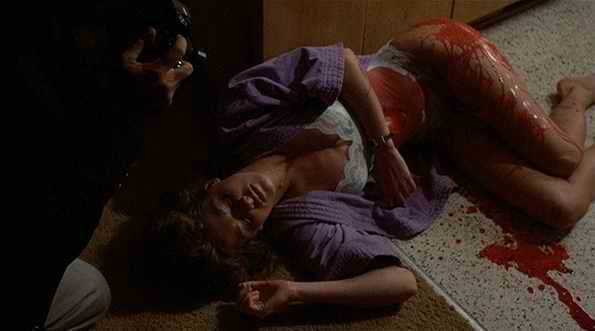
S/EX NOTE: What is amazing here is the reviewer’s knowledge of Bronson’s films and films in general, unlike most críticos americanos de la película .
10 TO MIDNIGHT DESIGUAL, AMBIVALENTE, EFECTIVA
Nuevo Herald, El (Miami, FL) - March 17, 1983
Gene Davis es Warren Stacey, un joven que muestra la inexpresiva concentracion de los absolutamente enajenados. Hacer llamadas telefonicas obscenas ya no le basta, y a intervalos cada vez mas horriblemente frecuentes, se desnuda de pies a cabeza y sale a acuchillar a las mujeres que le recuerdan su falta de exito con el sexo opuesto o su insinuada impotencia.
Gene Davis interpreta a Warren Stacey como si fuera Anthony Perkins en Psycho, reencarnado en el Jean-Michael Vincent de The Mechanic, bien parecido y mal intencionado, es el villano ideal para la nueva fantasia de venganza de Charles Bronson .
Al igual que Death Wish y su segunda parte, 10 to Midnight es una apologia para la reaccion de tomarse la justicia en propias manos ante la laxitud oficial contra una ola de crimenes.
Este es el tipo de pelicula en que el publico aplaude enardecido la final ejecucion por la libre. Un espectaculo extranamente perturbador, porque uno no sabe si aplaudir o repugnarse. Y es que el malo es tan anormal y Charles Bronson es tan recto y practico que el film esta jugando--muy deliberadamente--con cartas marcadas.
En 10 to Midnight , el policia Bronson mancha de sangre la chaqueta del loco, para tener evidencia judicial falsa, pero verdadera. Es exactamente lo mismo que hizo Orson Welles como otro policia, el Quinlan de Touch of Evil, una pelicula moralmente mas compleja y por tanto infinitamente superior.
La treta de Bronson es descubierta, pierde su puesto en la policia, pero ha mostrado su rostro y sus propositos ante el demente, que sale absuelto en la investigacion. Es la invitacion preordenada a que Gene Davis elija como blanco de su proximo asalto a Lisa Eilbacher, la enfermera hija de Charlie.
Cuando Bronson no exige estos melodramas esquematicos e inflamatorios, es capaz de hacer peliculas muy interesantes (From Noon Till Three, Breakheart Pass, St. Ives). Pero cada vez se va acercando mas a este genero supersimplificado en que los heroes son tan buenos y los malos son tan feroces que todo desemboca en una caceria sin sutileza.
Un joven escritor amigo mio escribio un solido guion, con Charles Bronson en mente para el papel protagonico. Se lo devolvieron como inservible, con el pretexto de que tenia mucho dialogo y que ahora Bronson queria hablar lo menos posible en la pantalla. El guion de que hablo era tan terso y economico que mas alla... solo quedaba el silencio y el monosilabo.
A ese limite casi llega Charlie en 10 to Midnight . Y como con un astro impavido hay que llenar el film con otros elementos, 10 to Midnight avanza hacia un sensacionalismo contundente. Acciones tan simples como abrir un zipper o freir un huevo se sobrecargan de tremebundos presagios. Y la abundancia de enormes close-ups parece indicar que 10 to Midnight ve su futuro no en la pantalla grande sino en Cable- TV.
En los ultimos veinte minutos, esta cinta torpe y chapucera se vuelve muy profesional. Es como si el director J. Lee Thompson hubiera estado cumpliendo una encomienda de rutina, rellenando pietaje hasta llegar a lo que realmente le interesaba.
J. Lee Thompson dirigio hace veinte anos Cape Fear, en la que el sadico Robert Mitchum invadia la casa de Gregory Peck para violar y asesinar a la esposa de Peck (Polly Bergen). Cape Fear es una trepidante pelicula de terror y todavia espeluzna cuando a cada rato la pasan por television.
Thompson ha revivido sus viejos trucos, ahora en forma mas truculenta -- o sea sanguinolenta--porque el cine ya es mas permisivo en la presentacion de la violencia. El resultado no es muy agradable, pero carezco de la hipocresia necesaria para negar que es muy efectivo como cine.
10 to Midnight es muy ambigua, muy desigual, muy ambivalente. Tanto, en fin, que me da bastante verguenza admitir que me gusto un poquito.
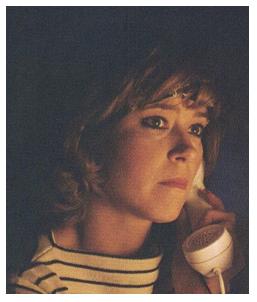
SHE’S CLOSING IN ON STARDOM ON BOTH SCREENS
Detroit Free Press (MI) - April 22, 1983
Author: BETTELOU PETERSON Free Press Television Writer
Lisa Eilbacher didn’t think the down parka suggested for her jaunt around the frigid Northeast this week was quite right. After all , how would it look with an evening gown?
So, she turned up in Detroit in a mink. Her first excursion, she said, into the sort of luxury most people associate with stardom. In fact, Eilbacher doesn’t think she’s really a star.
She’s getting close in both movies and TV. She was the struggling young recruit in "An Officer and a Gentleman" and co- starred with Charles Bronson in " Ten to Midnight .
On television, she was Robert Mitchum’s daughter in ABC’s "The Winds of War." Currently, she is Dr. Ingrid Sorenson, one of "Ryan’s Four," in the new ABC hospital drama series at 9 p.m. Wednesdays . Herewith, some pointed Eilbacher musings:
About being a presenter on the Oscar telecast:
"My business manager couldn’t believe it. There were big stars who were furious because they weren’t on the Oscars. I didn’t see much. They want you backstage five awards ahead and then you go to the press room with the winners. But I got to be backstage with people like Meryl Streep. I presented the awards for sound and I had all those Italian names. I’ll never forget them. I studied overnight but you get up there and it all goes out of your head. I’m blind as a bat without my glasses and the cue cards are so far back. They ask you if you can see the cue cards at rehearsal and if you say ’No,’ they yell ’BIG LETTERS FOR HER!’ It’s so embarrassing. They sell tickets to the public for those rehearsals."
About the importance to her career of "The Winds of War" and "An Officer and a Gentleman"?
"If I hadn’t done ’Officer and a Gentleman,’ I wouldn’t have been on the Oscars. For a young person, that’s a great opportunity to be seen by the biggest names in the movies. What it says to the industry, when there are people like Matt Dillon, Nastassia Kinski, myself, on the Oscar telecast is, these are the people we believe in. It’s like a stamp of approval."
About the future of "Ryan’s Four":
"It’ll go on but the question is whether it will be for 13 or 22 shows . We won’t know until May but they’re handling it with kid gloves, especially me. I never signed the contract, just didn’t. So, I don’t know. I don’t know if I should be doing a movie now instead. A feature career usually means more money and a longer career. It’s a big decision. I looked at all the people presenting Oscars. Tom Selleck was the only one who was doing both TV and features.
"I like the series. I want to do it. But I don’t want to give up features. It’s all in timing. I can come back to a television series in five years but I can’t always do features."
About the possibility of a sequel to "The Winds of War":
"I haven’t heard any talk in that direction. If they did it, it wouldn’t be soon. I was told I was the only who’d be young enough to do my role again . You know what they wanted to do after ’The Winds of War’? They wanted me to ’Good Morning, America’ with Victoria Tennant and David Dukes as the only people who survived unscathed by the critics.
"That didn’t seem like a good idea to me. You know why? I’m absolutely nuts about Ali MacGraw. She’s one of the nicest ladies. She was not that bad -- she played the character as it was written. She is the most insecure person about her acting. She’s the first person to say to you, ’Was I awful?’ "
Lisa Eilbacher
REAL NAME: Lisa Eilbacher
BIRTHDAY: May 5, 1956, Dhahran, Saudi Arabia
LOVELIFE: Engaged to cinematograher Bradford May.
EDUCATION: Elementary school in Paris, Geneva, Switzerland; Beverly Hills High School, Calif.
CAREER: TV debut, commercials, 1960; acting debut , "Wagon Train," 1961; Emmy nomination, best supporting actress, "Alias Smith and Jones," 1972; TV mini-series, "Wheels," NBC, 1978; "The Winds of War," ABC, 1983; TV series: "Hardy Boys Mysteries," ABC , 1977-78; "Ryan’s Four." ABC, 1983; TV movie, "The Patty Hearst Story," ABC, 1979; feature film debut, "The War Between Men and Women," 1972; feature films include "An Officer and a Gentleman," 1982 .
No comments:
Post a Comment